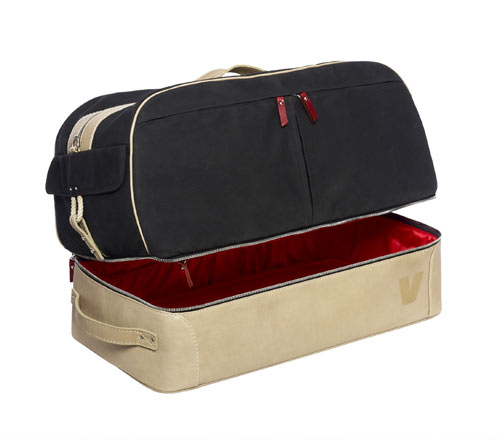The Perfect Bag: Interview with Steven Alan
How Steven Alan crowdsourced the perfect travel bag


When the new airline V Australia asked clothing retailer and designer Steven Alan to come up with the ultimate travel bag, the always-affable New Yorker turned to the online community for their suggestions. Traveling to Australia for inspiration, Steven blogged about his trip, using the website to tap the Twitter community. The upshot incorporates crowd-sourced high function with a clean look accented by the designer’s playfully classic take on materials. We took a minute recently to check in with Steven about the experience and how he came up with secret backpack straps that also evade bathroom cooties.
Cool Hunting: What was the origin of the social media aspect of designing the bag?
Steven Alan:
Well when they proposed a trip, I thought we should document it somehow—take pictures, blog about it. The other thing I thought would be great would be if people could contribute their thoughts in terms of traveling, like I wish I had this for my bag, I wish I had this for my computer, etc. I asked a lot of people what they wanted, because it’s silly to design a functional bag and not ask what’s needed.
For me it was important, because everyone usually does the same thing. There’s a tote, a duffle, a backpack. Aside from that, if you want to rethink the bag, where are you gonna go? I wanted to do something that really felt different. I think that this bag is classic, but it’s definitely a certain take on it which I haven’t seen.
Was there anything unexpected that happened in the design process?
The first idea was something that basically had backpack straps but they were hidden on the bottom of the bag, because I didn’t want it to look like a backpack. I had seen this before but we sketched it out and then afterward I was playing around with it and started thinking about the last time I was traveling and went to the bathroom and put the bag down on the floor, which is kind of gross. That’s the part you’re putting on your back, right? So I was like okay, I can’t do that. I figured out a way to re-engineer it so that the straps were actually on the front without it looking like a backpack.
How did this process differ from your other approaches?
You mean the collaborative experience? It’s not that different. I think that was one of the original reasons V had contacted me, because I always think about it. How am I going to make the perfect shirt? How do I make the perfect vest?
I think a lot of designers think about the collection. A lot of times people make stuff as filler. Because you have to have a runway show, whatever. But I think because I’m also a retailer I have a close connection with my customer. I think about it and if I can’t have my own identity to it, then it’s better to leave it out. To date we haven’t really done a big denim thing, because I haven’t really had anything to say about denim jeans, whereas there’s a lot of other stuff that I do because I think “Oh I would like to do that, that would be neat.”
So would you say in general you’re driven more by function?
I think for me because I’m not trained as a designer—I don’t sketch, I don’t drape and stuff like that—really the best way to kind of analyze it is to see it. Once I describe it, I work with the design team, then they’ll sketch it out and once it’s sketched I’ll say, “you know, maybe it needs bigger pockets” because the proportion thing for me is easy. I can’t articulate it in terms of drawing it. Once it’s on a model, it’s even easier. I like fabrics a lot, I like playing with fabrics. I like to say “ok lets take this Woolrich fabric and make gloves out of it.”
Do you ever find it challenging to not know the more technical side of it?
Having a client is different than anything else I’ve done. I’m doing something custom for them, as opposed to “this is my bag, here buy it.” It has to work with my aesthetic but it also has to work with theirs. So it was challenging to be able to do something—it was almost like working at an advertising company and coming out with a campaign.
For example, our first sample had slots for a computer and we thought it worked, and we sent it to them for final approval and they said their size computer didn’t work. Ultimately, we’re getting a better bag out of it I think.












